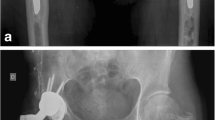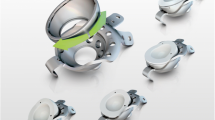Abstract
Purpose
To evaluate the clinical and radiological outcomes of acetabular reconstruction using a reinforcement device (RD) in combination with bone grafting in Paprosky type 2 and 3 acetabular bone defects.
Methods
Morselised bone grafts were used to fill cavitary defects and a structural graft placed in the superior part of the acetabulum in cases of cranial bone defects, with a proximally fixed RD (Protetim, Hódmezővásárhely, Hungary) implanted in all cases. Construct stability, device positioning, hip centre of rotation and medial acetabular wall thickness were evaluated radiologically. Survival rates were estimated with aseptic loosening and revision for any reason as endpoints.
Results
The 28 patients (29 hips) were followed for 4.8 ± 2.7 years (range, 2-10.4 years). Hip centre of rotation was lowered in all cases, with no significant differences between the mean values obtained post-operatively and at the last follow-up. Medial acetabular wall thickness and RD abduction angle were maintained up to the last evaluation. Bone grafts integrated by two years post-operatively in the majority of cases. Kaplan-Meier survival rates were 85.2 % and 82.1 % for the two endpoints at ten years.
Conclusions
Acetabular reconstruction using a proximally fixed RD in combination with bone grafting offered good mid-term results in the treatment of acetabular bone defects. In cases of severe bone loss, the structural allograft allowed placement of the RD with ischial contact, rendering survival rates similar to RDs with both iliac and ilioischial fixation. The technique was successful in restoring and maintaining medial acetabular bone stock and construct stability for up to ten years.





Similar content being viewed by others
References
Dunbar MJ, Howard A, Bogoch ER, Parvizi J, Kreder HJ (2009) Orthopaedics in 2020: predictors of musculoskeletal need. J Bone Joint Surg Am 91(9):2276–2286. doi:10.2106/JBJS.H.01521
Ulrich SD, Seyler TM, Bennett D, Delanois RE, Saleh KJ, Thongtrangan I, Kuskowski M, Cheng EY, Sharkey PF, Parvizi J, Stiehl JB, Mont MA (2008) Total hip arthroplasties: what are the reasons for revision? Int Orthop 32(5):597–604. doi:10.1007/s00264-007-0364-3
Taylor ED, Browne JA (2012) Reconstruction options for acetabular revision. World J Orthop 3(7):95–100. doi:10.5312/wjo.v3.i7.95
Pereira GC, Kubiak EN, Levine B, Chen FS, Di Cesare PE (2007) Cavitary acetabular defects treated with morselized cancellous bone graft and cementless cups. Int Orthop 31(4):445–450. doi:10.1007/s00264-006-0220-x
Friedrich MJ, Schmolders J, Michel RD, Randau TM, Wimmer MD, Kohlhof H, Wirtz DC, Gravius S (2014) Management of severe periacetabular bone loss combined with pelvic discontinuity in revision hip arthroplasty. Int Orthop 38(12):2455–2461. doi:10.1007/s00264-014-2443-6
Inoue D, Kabata T, Maeda T, Kajino Y, Yamamoto T, Takagi T, Oomori T, Tsuchiya H (2015) The value of bulk femoral head allograft in acetabular reconstruction using Kerboull-type plate. Int Orthop 39(9):1839–1844. doi:10.1007/s00264-015-2857-9
Abolghasemian M, Sadeghi Naini M, Tangsataporn S, Lee P, Backstein D, Safir O, Kuzyk P, Gross AE (2014) Reconstruction of massive uncontained acetabular defects using allograft with cage or ring reinforcement: an assessment of the graft’s ability to restore bone stock and its impact on the outcome of re-revision. Bone Joint J 96-B(3):319–324. doi:10.1302/0301-620X.96B3.32850
Mao Y, Xu C, Xu J, Li H, Liu F, Yu D, Zhu Z (2015) The use of customized cages in revision total hip arthroplasty for Paprosky type III acetabular bone defects. Int Orthop 39(10):2023–2030. doi:10.1007/s00264-015-2965-6
Gross AE (2006) Restoration of acetabular bone loss 2005. J Arthroplasty 21(4 Suppl 1):117–120
Berry DJ (2004) Antiprotrusio cages for acetabular revision. Clin Orthop Relat Res 420:106–112
Schlegel UJ, Bitsch RG, Pritsch M, Clauss M, Mau H, Breusch SJ (2006) Mueller reinforcement rings in acetabular revision: outcome in 164 hips followed for 2-17 years. Acta Orthop 77(2):234–241. doi:10.1080/17453670610045966
Paprosky WG, Perona PG, Lawrence JM (1994) Acetabular defect classification and surgical reconstruction in revision arthroplasty. A 6-year follow-up evaluation. J Arthroplasty 9(1):33–44
Gill TJ, Sledge JB, Muller ME (1998) The Burch-Schneider anti-protrusio cage in revision total hip arthroplasty: indications, principles and long-term results. J Bone Joint Surg (Br) 80(6):946–953
Pierchon F, Migaud H, Duquennoy A, Fontaine C (1993) Radiologic evaluation of the rotation center of the hip. Rev Chir Orthop Reparatrice Appar Mot 79(4):281–284
Pascarel X, Liquois F, Chauveaux D, Le Rebeller A, Honton JL (1993) The use of Muller acetabular rings in revision surgery of total hip prosthesis. Apropos of 141 cases with a minimal 5-year follow-up. Rev Chir Orthop Reparatrice Appar Mot 79(5):357–364
Bonnomet F, Clavert P, Gicquel P, Lefebvre Y, Kempf JF (2001) Reconstruction by graft and reinforcement device in severe aseptic acetabular loosening: 10 years survivorship analysis. Rev Chir Orthop Reparatrice Appar Mot 87(2):135–146
Massin P, Tanaka C, Huten D, Duparc J (1998) Treatment of aseptic acetabular loosening by reconstruction combining bone graft and Muller ring. Actuarial analysis over 11 years. Rev Chir Orthop Reparatrice Appar Mot 84(1):51–60
Philippe R, Gosselin O, Sedaghatian J, Dezaly C, Roche O, Sirveaux F, Mole D (2012) Acetabular reconstruction using morselized allograft and a reinforcement ring for revision arthroplasty with Paprosky type II and III bone loss: survival analysis of 95 hips after 5 to 13 years. Orthop Traumatol Surg Res 98(2):129–137. doi:10.1016/j.otsr.2011.11.003
Kowalczewski JB, Rutkowska-Sak L, Marczak D, Slowinska I, Slowinski R, Sibinski M (2013) Bone graft incorporation after revision hip arthroplasty in patients with rheumatoid arthritis: seventy eight revisions using bone allografts with or without metal reinforcements. Int Orthop 37(4):595–598. doi:10.1007/s00264-013-1794-8
Kawanabe K, Akiyama H, Onishi E, Nakamura T (2007) Revision total hip replacement using the Kerboull acetabular reinforcement device with morsellised or bulk graft: results at a mean follow-up of 8.7 years. J Bone Joint Surg (Br) 89(1):26–31. doi:10.1302/0301-620X.89B1.18037
Kerboull M, Hamadouche M, Kerboull L (2000) The Kerboull acetabular reinforcement device in major acetabular reconstructions. Clin Orthop Relat Res 378:155–168
Hori J, Yasunaga Y, Yamasaki T, Yoshida T, Oshima S, Yamasaki K, Matsuo T, Ochi M (2012) Mid-term results of acetabular reconstruction using a Kerboull-type acetabular reinforcement device. Int Orthop 36(1):23–26. doi:10.1007/s00264-011-1248-0
Kim DH, Cho SH, Jeong ST, Park HB, Hwang SC, Park JS (2010) Restoration of the center of rotation in revision total hip arthroplasty. J Arthroplasty 25(7):1041–1046. doi:10.1016/j.arth.2009.07.023
Bicanic G, Delimar D, Delimar M, Pecina M (2009) Influence of the acetabular cup position on hip load during arthroplasty in hip dysplasia. Int Orthop 33(2):397–402. doi:10.1007/s00264-008-0683-z
Zuh SG, Zazgyva A, Gergely I, Pop TS (2015) Acetabuloplasty with bone grafting in uncemented hip replacement for protrusion. Int Orthop 39(9):1757–1763. doi:10.1007/s00264-015-2804-9
Author information
Authors and Affiliations
Corresponding author
Ethics declarations
Conflict of interest
The authors declare that they have no conflict of interest.
Ethical approval
All procedures performed involving human participants were in accordance with the ethical standards of the institutional and/or national research committee and with the 1964 Helsinki declaration and its later amendments or comparable ethical standards. For this type of study formal consent is not required.
Rights and permissions
About this article
Cite this article
Zazgyva, A., Zuh, SG., Roman, C.O. et al. Acetabular reconstruction with a reinforcement device and bone grafting in revision arthroplasty—a mean five years of follow-up. International Orthopaedics (SICOT) 40, 1631–1638 (2016). https://doi.org/10.1007/s00264-015-3030-1
Received:
Accepted:
Published:
Issue Date:
DOI: https://doi.org/10.1007/s00264-015-3030-1




